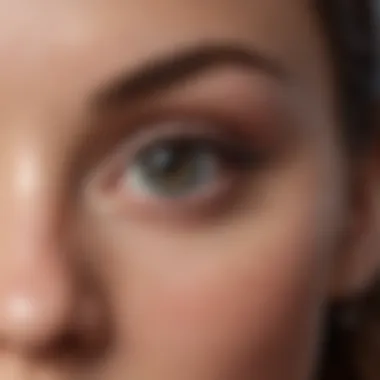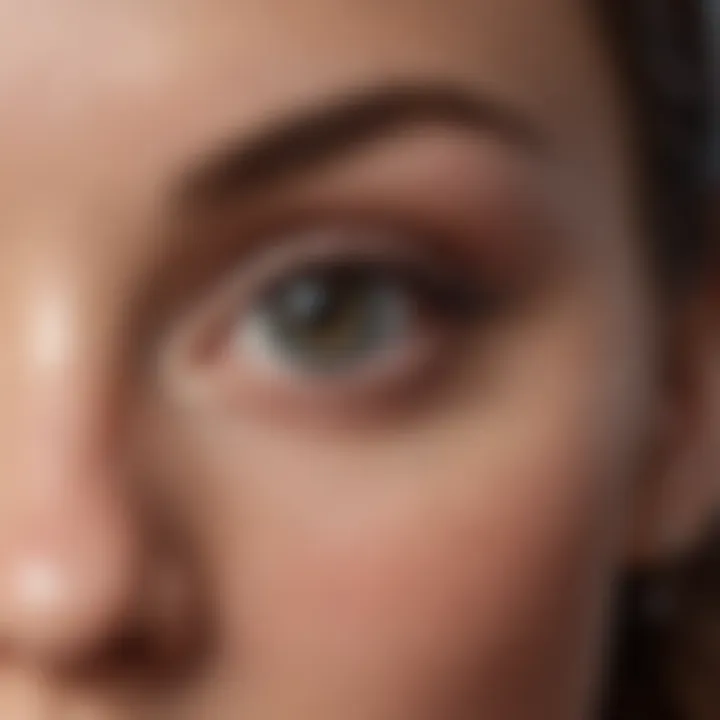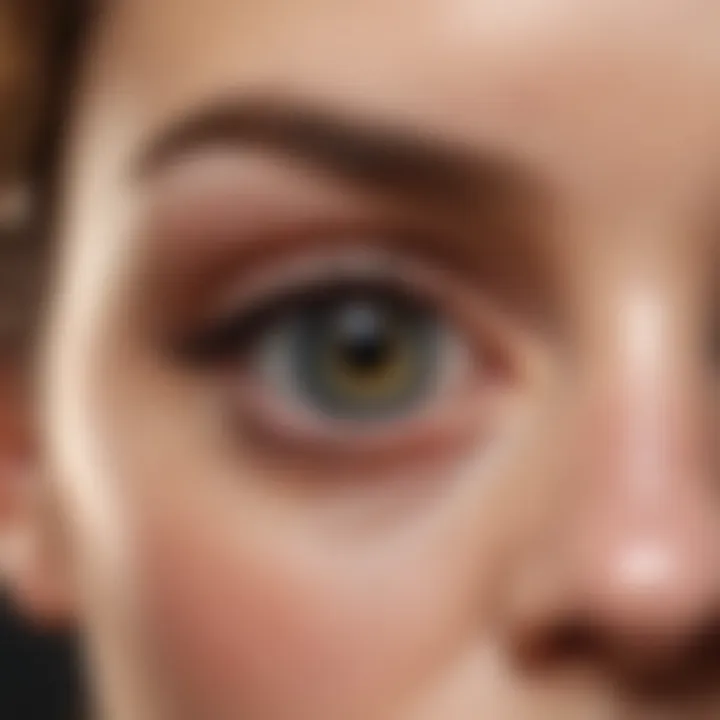Unraveling the Diverse Causes of Swelling Under Eyes for a Radiant Look


Swelling under the eyes can be a common issue that many individuals face. There are various factors that can contribute to this cosmetic concern, ranging from lifestyle habits to underlying health conditions. Understanding the causes behind eye puffiness is crucial in addressing and managing this issue effectively.
Introduction
Swelling under the eyes is a common cosmetic concern that plagues individuals globally. Understanding the root causes of this issue is essential for effectively addressing and mitigating it. By delving into the triggers behind eye puffiness, one can embark on a journey towards finding suitable remedies and preventive measures. This article serves as a comprehensive guide, aiming to shed light on the diverse factors contributing to under-eye swelling, empowering readers with the knowledge to tackle this common phenomenon.
Understanding Swelling Under Eyes
Swelling under the eyes, also known as periorbital puffiness, occurs due to various reasons such as lack of sleep, allergies, fluid retention, poor diet, dehydration, sinus infections, thyroid disorders, dermatitis, hormonal imbalance, and underlying medical conditions. This puffiness can result in a tired and aged appearance, affecting one's overall facial aesthetics.
Importance of Identifying Causes
Identifying the specific causes of under-eye swelling is crucial for implementing targeted treatment plans. By pinpointing the underlying factors contributing to puffiness, individuals can adopt lifestyle changes, dietary modifications, or medical interventions to address the root of the issue effectively. Failing to identify the causes may result in temporary solutions that do not provide lasting relief from under-eye swelling. Therefore, a comprehensive understanding of the triggers behind this condition is paramount for personalized care and long-term wellness.
Common Causes
Swelling under the eyes can be attributed to various factors, highlighting the importance of understanding common causes in addressing this issue effectively. By exploring these factors, individuals can grasp the underlying reasons behind this cosmetic concern, enabling them to make informed decisions regarding treatment and prevention strategies. Among the common causes of under-eye swelling are lack of sleep, allergies, fluid retention, poor diet, and dehydration.
Lack of Sleep
Inadequate sleep is often a major contributor to puffiness under the eyes. When individuals do not get sufficient rest, it can lead to fluid retention and blood vessel dilation, causing the delicate skin under the eyes to appear swollen and puffy. Lack of sleep impacts skin health, diminishing its ability to regenerate and repair, further exacerbating under-eye puffiness.
Allergies
Allergic reactions can manifest as under-eye swelling due to the release of histamines in the body. These histamines cause blood vessels to dilate, leading to puffiness and dark circles under the eyes. Common allergens such as pollen, pet dander, or dust can trigger this response in sensitive individuals, emphasizing the importance of identifying and addressing allergies effectively.
Fluid Retention


Excessive intake of sodium, hormonal fluctuations, or certain medical conditions can cause fluid retention, leading to under-eye swelling. When the body retains fluid, it can accumulate in the under-eye area, resulting in puffiness. Understanding the root cause of fluid retention is crucial in managing under-eye swelling effectively.
Poor Diet
A diet high in salt, sugar, and processed foods can contribute to under-eye puffiness. Consuming excess salt can lead to fluid retention, while sugary foods can cause inflammation, both of which can manifest as swelling under the eyes. A diet rich in fruits, vegetables, and whole grains can help combat under-eye puffiness by providing essential nutrients for skin health.
Dehydration
Dehydration affects skin elasticity and can exacerbate under-eye puffiness. When the body lacks proper hydration, the skin under the eyes may appear sunken and hollow, accentuating the appearance of puffiness. Staying hydrated by drinking an adequate amount of water is essential in preventing under-eye swelling caused by dehydration.
Health-Related Causes
As we explore the myriad factors contributing to swelling under the eyes, delving into health-related causes unveils crucial insights that play a significant role in understanding this issue. Health-related causes encompass a range of conditions and imbalances within the body that can manifest as puffiness and swelling in the delicate under-eye area. It is essential to highlight the importance of considering health-related factors, as they can often be indicative of underlying medical issues or systemic imbalances that require attention and management. By focusing on health-related causes, we prioritize a holistic approach to addressing eye swelling, emphasizing the interconnectedness of overall health and cosmetic concerns.
Sinus Infections
Sinus infections, medically known as sinusitis, can contribute to swelling under the eyes due to the inflammation and congestion characteristic of this condition. When the sinuses become blocked or infected, it can lead to pressure buildup in the facial region, including the under-eye area. This increased pressure and inflammation can cause the eyes to appear puffy and swollen. Addressing sinus infections promptly through proper treatment and management can help alleviate under-eye swelling associated with this health-related cause.
Thyroid Disorders
Thyroid disorders, such as hypothyroidism or hyperthyroidism, can impact various bodily functions, including fluid regulation and metabolism. Imbalances in thyroid hormones can result in water retention and puffiness in different parts of the body, including the eyes. Swelling under the eyes can be a visible indicator of thyroid dysfunction, highlighting the importance of considering thyroid disorders as a potential cause. Managing thyroid conditions through medication and lifestyle adjustments can help reduce under-eye swelling associated with thyroid disorders.
Dermatitis
Dermatitis refers to inflammation of the skin, which can occur due to various triggers such as allergies, irritation, or immune reactions. In the context of swelling under the eyes, dermatitis can lead to redness, puffiness, and itching in the delicate skin around the eyes. Identifying the specific triggers of dermatitis, whether it be from skincare products, allergens, or underlying skin conditions, is essential in addressing under-eye swelling associated with dermatitis. Proper skincare, avoidance of irritants, and potential medical treatments can help manage dermatitis-induced eye puffiness.
Hormonal Imbalance


Hormonal imbalances, especially fluctuations in estrogen and progesterone levels, can affect fluid retention and skin properties, potentially leading to under-eye swelling. Women may experience hormonal imbalance-related puffiness during menstrual cycles, pregnancy, or menopause. Understanding the role of hormones in regulating fluid balance and skin health is key in addressing hormonal imbalance as a causative factor for eye swelling. Hormone management through lifestyle adjustments or medical interventions can help alleviate under-eye puffiness associated with hormonal imbalances.
Underlying Medical Conditions
Underlying medical conditions such as kidney disease, heart conditions, or allergies can manifest as swelling under the eyes. Addressing the root cause of under-eye swelling related to specific medical conditions requires thorough medical evaluation and targeted treatment approaches. By identifying and managing underlying medical issues, individuals can effectively reduce persistent eye puffiness associated with these conditions.
Behavioral and Lifestyle Factors
In diving deep into the causes of swelling under the eyes, Behavioral and Lifestyle Factors emerge as crucial elements in this discussion. Understanding how our behaviors and lifestyles impact our physical appearance helps shed light on potential triggers for eye puffiness. Consistent patterns of alcohol consumption, smoking, stress levels, and habits like frequently rubbing or scratching the eyes can all contribute to swelling under the eyes. Recognizing the role of Behavioral and Lifestyle Factors allows us to take proactive steps towards reducing eye puffiness and improving overall skin health.
Alcohol Consumption
Alcohol consumption is a significant behavioral factor linked to swelling under the eyes. Excessive drinking can lead to dehydration, which is a common cause of eye puffiness. Alcohol also dilates blood vessels, leading to increased blood flow around the eyes and exacerbating the appearance of puffiness. Moreover, alcohol can disrupt sleep patterns, further contributing to tired-looking eyes and swelling. Understanding the impact of alcohol consumption on eye health is crucial for individuals looking to address under-eye swelling.
Smoking
Smoking is another behavioral factor that can negatively affect the skin around the eyes. The chemicals in cigarettes constrict blood vessels, reducing blood flow and oxygen levels to the skin. This can result in a dull complexion, fine lines, and puffiness under the eyes. Additionally, smoking accelerates the breakdown of collagen and elastin, essential proteins for maintaining skin firmness and elasticity. By quitting smoking, individuals can improve the overall health and appearance of their skin, including reducing under-eye puffiness.
Stress
Stress plays a significant role in skin health, including the appearance of puffiness under the eyes. High levels of stress trigger the release of cortisol, a hormone that can lead to inflammation and fluid retention in the body. This can manifest as swelling under the eyes, giving a tired and puffy appearance. Chronic stress can also disrupt sleep patterns, exacerbating eye puffiness. Managing stress through relaxation techniques, exercise, and adequate sleep can help reduce under-eye swelling and improve overall skin health.
Rubbing or Scratching Eyes
The habit of rubbing or scratching the eyes can contribute to swelling and puffiness in the delicate skin under the eyes. The skin around the eyes is thin and sensitive, making it prone to irritation and inflammation when subjected to repeated rubbing or scratching. This can lead to broken capillaries, dark circles, and puffiness. Breaking the habit of touching or rubbing the eyes and using gentle skincare products can help prevent irritation and reduce under-eye swelling. Understanding the detrimental effects of this behavior is essential for maintaining healthy and vibrant skin around the eyes.
Genetic Factors


Genetic factors play a crucial role in understanding the causes of swelling under the eyes. These hereditary elements can significantly influence an individual's predisposition to this cosmetic concern. By examining genetic factors, we delve into the intricate nuances of how eye puffiness can be inherited within families and across generations. Understanding the genetic component of under-eye swelling provides valuable insights into why some individuals may be more prone to this issue compared to others. Through an exploration of genetic factors, we can uncover patterns and trends that shed light on the underlying reasons behind this common problem.
Family History
Within the realm of genetic factors, family history stands out as a key aspect worth considering. An individual's family history can offer vital clues about their likelihood of experiencing swelling under the eyes. By tracing patterns of eye puffiness within the family tree, one can discern potential genetic predispositions that may contribute to this condition. Analyzing family history not only helps in identifying possible hereditary factors but also aids in assessing the risk levels associated with under-eye swelling based on familial trends and occurrences. This insight into family history can guide individuals in understanding the inherited aspects of this issue and determining appropriate preventive measures or treatments.
Aging and Skin Changes
In the realm of factors causing swelling under the eyes, the aging process plays a significant role. Age gracefully as it may, the skin undergoes various transformations that can contribute to puffiness and bags under the eyes. With aging, the skin naturally loses its elasticity and firmness, key components that maintain a youthful appearance. This loss of skin elasticity leads to sagging and drooping skin, especially around the delicate eye area. Understanding the implications of skin aging is crucial in addressing issues related to under-eye swelling effectively. By recognizing the impact of aging on the skin, individuals can tailor their skincare routines and lifestyle choices to mitigate the effects and maintain a more youthful appearance.
Loss of Skin Elasticity
One of the primary consequences of aging on the skin is the gradual decline in skin elasticity. Elasticity, responsible for skin's ability to snap back into place after being stretched, diminishes over time due to reduced collagen and elastin production. Collagen, a protein that provides structural support to the skin, and elastin, which maintains skin flexibility, decline as part of the natural aging process. Consequently, the skin becomes lax and prone to sagging, leading to the formation of wrinkles and fine lines. In the context of under-eye swelling, the loss of skin elasticity contributes to the development of bags and puffiness, as the skin in this area is less able to bounce back, resulting in a tired and aged appearance.
Fat Redistribution
Another aspect of aging that can impact under-eye swelling is the redistribution of fat in the face. As individuals age, the fat pads that provide volume and cushioning to the face undergo changes in distribution. In particular, fat beneath the eyes can shift or diminish, causing hollowing or depressions that accentuate dark circles and under-eye bags. The redistribution of fat can create shadows and hollow areas that give the illusion of swelling under the eyes, even in the absence of actual puffiness. Understanding how fat redistribution affects facial anatomy is essential in recognizing the underlying causes of under-eye concerns and implementing strategies to address them effectively.
Environmental Triggers
Exposure to Pollution
One substantial environmental trigger that can exacerbate swelling under the eyes is exposure to pollution. In our modern urban landscapes, pollution has become a pervasive issue with detrimental effects on our skin health. Particles in the air can penetrate the delicate skin around the eyes, leading to irritation and inflammation. Prolonged exposure to pollutants can compromise the skin's natural barrier function, resulting in increased water loss and potential puffiness. Understanding the impact of pollution on eye swelling underscores the importance of protecting our skin from harmful environmental elements. Implementing proper skincare routines and using products with anti-pollution properties can help shield the delicate eye area from the adverse effects of pollution, mitigating the risk of swelling.
UV Radiation
Another critical environmental trigger for swelling under the eyes is UV radiation. The sun's harmful UV rays not only accelerate skin aging but also contribute to various skin concerns, including puffiness. Excessive sun exposure can lead to collagen breakdown and elastin damage, causing the skin around the eyes to lose its resilience and firmness. UV radiation can also trigger skin pigmentation issues, further accentuating the appearance of under-eye swelling. Protecting the delicate eye area from UV damage is essential in preventing and reducing eye puffiness. Incorporating broad-spectrum sunscreen and wearing UV-protective sunglasses can shield the skin from harmful radiation, preserving its youthfulness and reducing the risk of swelling. By recognizing the impacts of UV radiation on eye health, we can prioritize sun protection as a fundamental aspect of our skincare regimen.
Conclusion
Swelling under the eyes can be a distressing cosmetic concern that is often influenced by various factors. In this article, we have meticulously explored the diverse causes of eye puffiness, aiming to provide readers with a thorough understanding of this common issue. By delving into different reasons behind swelling under the eyes, individuals can gain valuable insights into the potential triggers for this aesthetic problem. It is crucial to comprehend the underlying factors contributing to eye puffiness to facilitate targeted solutions and effective management strategies for addressing this issue.
Importance of Addressing Underlying Causes
The significance of addressing the underlying causes of swelling under the eyes cannot be overstated. By recognizing and tackling the root factors responsible for eye puffiness, individuals can not only alleviate the immediate cosmetic concerns but also potentially prevent its recurrence. Understanding the underlying causes enables individuals to make informed lifestyle choices, implement necessary changes, and seek appropriate medical interventions when essential. Addressing the core reasons for eye swelling is imperative for long-term management and improving overall eye health and appearance.



